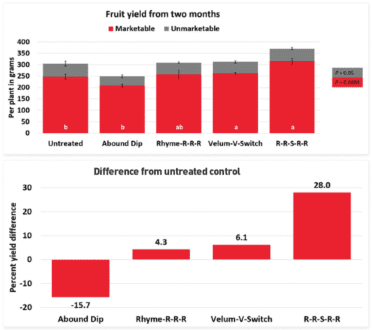

Jan 7, 2021California studies drip applications for strawberries
Applying fungicides in strawberry via drip irrigation may become the standard in protecting the fruit from its many soil, fruit and foliar diseases.
A new study from the University of California Agriculture and Natural Resources (UC ANR) conducted at the Shafter Research Station in California has shown some promising results for preventing disease and the effects on strawberry health and yield.
In a field known to be infested with fusarium wilt, macrophomina crown rot, and botrytis fruit rot based on the symptoms seen in the previous year’s crop, Surendra Dara, UC Cooperative Extension advisor in entomology and biologicals, compared untreated plants, plants treated by dipping in fungicides and plants that received fungicides via drip application.
“Growers don’t generally drip apply these fungicides because fumigation is the main way to control soilborne pathogens,” Dara said.
If growers skip fumigation and wait until they see disease symptoms before applying fungicide, it might be too late. UC ANR is currently exploring alternatives to fumigants. The Shafter field in this study was not fumigated.
The plants treated with drip application saw significantly higher levels of leaf chlorophyll and leaf nitrogen compared to the untreated plants. The average sugar content and fruit firmness were unaffected and remained consistent across all treatments.
Lack of visible symptoms


advisor in entomology and biologicals,
compared untreated plants, plants treated
by dipping fungicides and plants that
received fungicides via drip application.
Photo: University of California
Dara chose this particular field because it had exhibited clear signs of pathogen infestation in the season prior to the study. With the fields being nonfumigated, he expected to see those same symptoms again.
“(In 2019), we had a severe problem, and the pathogens that cause charcoal rot and fusarium wilt were in the soil,” Dara said. “The plants were affected by April or May, and by the time we were getting close to the end of the study, the plants were wilted and dying.” When the soil samples were sent, the lab confirmed the presence of both fungal pathogens.
The field was left untreated and the pathogens remained, which made it an ideal scenario to test various fungicide treatments and their effects.
“But, somehow, we did not see the diseases. The inoculum is in the soil, but we did not see the disease symptoms in the plants during the study period,” Dara said.
In theory, the fungicides may have done their job in protecting the plant and helping it to grow. This would also mean that disease symptoms should have shown up in the untreated control group. Environmental stresses, like heat, can also exacerbate conditions that lead to disease.
However, the untreated control showed no symptoms.
“Sometimes, it’s the environment,” Dara said. “If the plants are really healthy and the inoculum stays low, the plants might be able to withstand disease.”


Grower standard questioned
One observation came from the reduced yield of the plants treated by dipping in fungicide prior to planting.
These plants saw a 16% reduction in yield compared to the plants that weren’t treated at all.
Dave Peck (pictured at top), general manager of Manzanita Berry Farms in Santa Maria, conducted his own study in 2019 to determine why the grower standard was performing so poorly. After California strawberries suffered widespread damage from anthracnose during the 2015-16 growing season, Manzanita adopted a pre-plant fungicide dip method in order to prevent fungal infections. It was in the following growing seasons that Manzanita noticed consistent underperformance in its plants.
“What caught my interest was that for a couple of years in a row, all of a sudden our grower’s standard tended way low compared to historical averages, and were all of a sudden substandard. We don’t usually see that,” Peck said. “We took it one step further and looked at all the variables going on at our ranch, and we discovered that just a couple of years before that, we started to dip our plants when anthracnose became an issue with strawberry plants out of the nurseries.”
The 2019 study discovered that plants dipped in Switch or PhycoTerra yielded less fruit than plants that had been dipped in water or had not been dipped at all.
The 2020 drip application study at Shafter reflected similar results, with the underperformance of transplants dipped in Abound, as did plants that received a biostimulant and fungicide, rather than just a biostimulant.
While dipping transplants is an industry-accepted preventative measure to protect against fungal pathogens, this new information may have growers rethinking their fungicide programs. Without the presence of disease symptoms in the field during the 2020 study, the research can’t say for certain. However, when comparing the Shafter and Manzanita studies, the practice of dipping transplants seems to be inducing a level of stress too early in the plants’ establishment, stunting their growth and causing lower yields in comparison to their untreated and drip-applied counterparts.
Peck advises that for any new product, not just fungicides, that growers test a small area first with their particular varieties and soils before making it a fieldwide practice. Misapplication of products can yield detrimental results, but proper use – even if the chemicals may be phytotoxic – could prevent worse problems with diseases.
These last two years have been the best production years Manzanita has had in a long time. In addition to the fact the plants weren’t dipped, Peck credits the yield to a number of factors – the plant variety, the nursery plant stock, the weather.
“All of that was superior,” Peck said.
Peck’s successful years further support Dara’s idea that strong, healthy plants can indeed withstand some environments containing infested soils. And while Manzanita no longer dips its plants, Peck would reconsider if the nurseries recommended it due to a known significant issue.
“If you think you need a fungicide dip, try some on your own variety first and see if, one, it solves your problem and, two, if it creates a new problem you didn’t have before,” Peck said.
Research is suggesting to apply the applications as needed, instead of a blanket approach before the plants even go into the ground. While each field – and each field’s farming practices – is different, it’s important to try to understand the possible interactions happening in the field, as there may be several among chemicals and biologicals that can greatly impact yield and have yet to be understood.
— Crystal Nay, Western editor; Pictured at top: Dave Peck, general manager of Manzanita Berry Farms in Santa Maria, California, conducted his own study in 2019 to determine why the grower standard was performing so
poorly. Photo courtesy of California Strawberry Commission.














